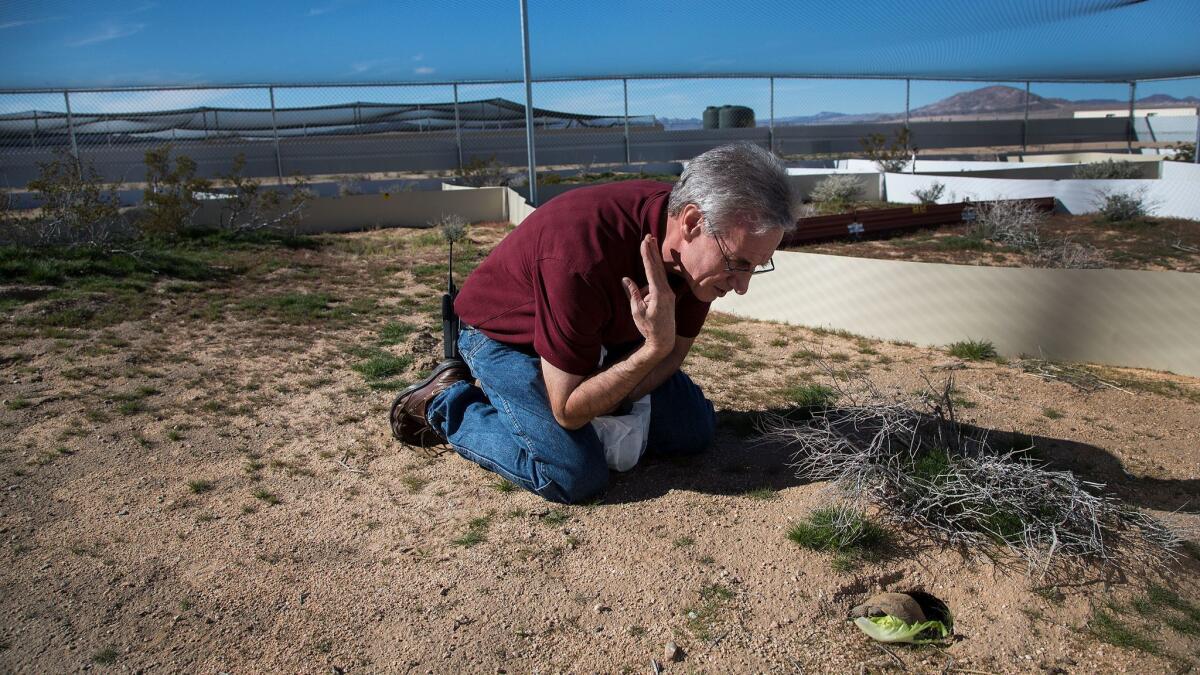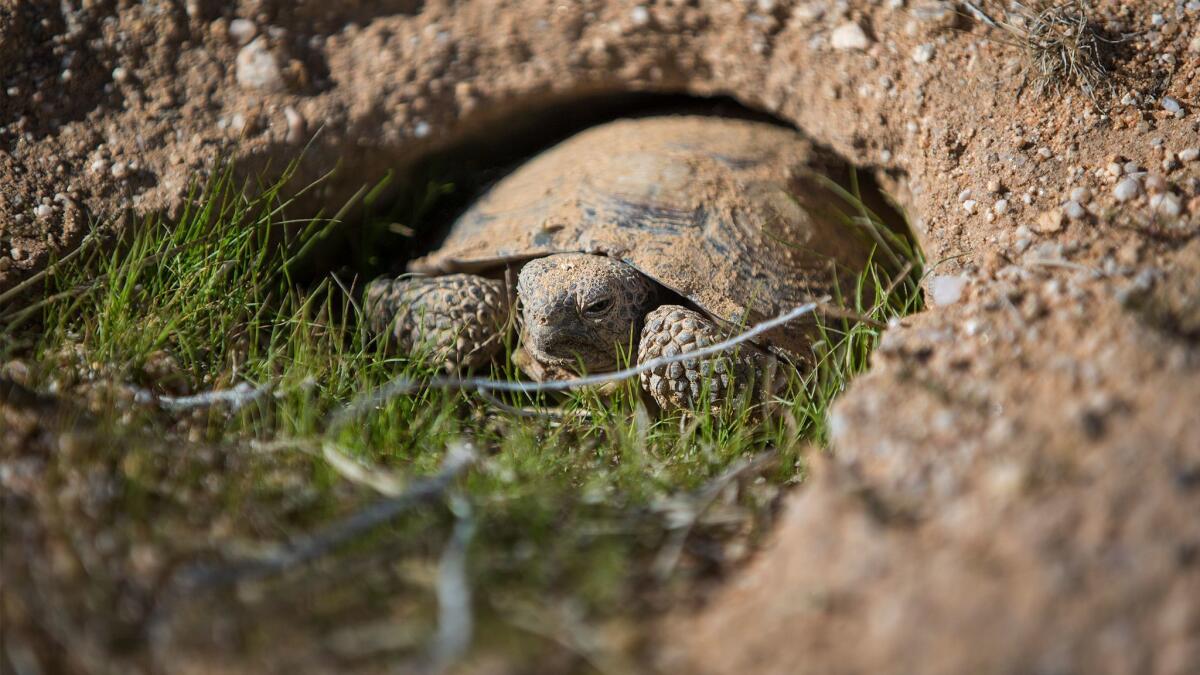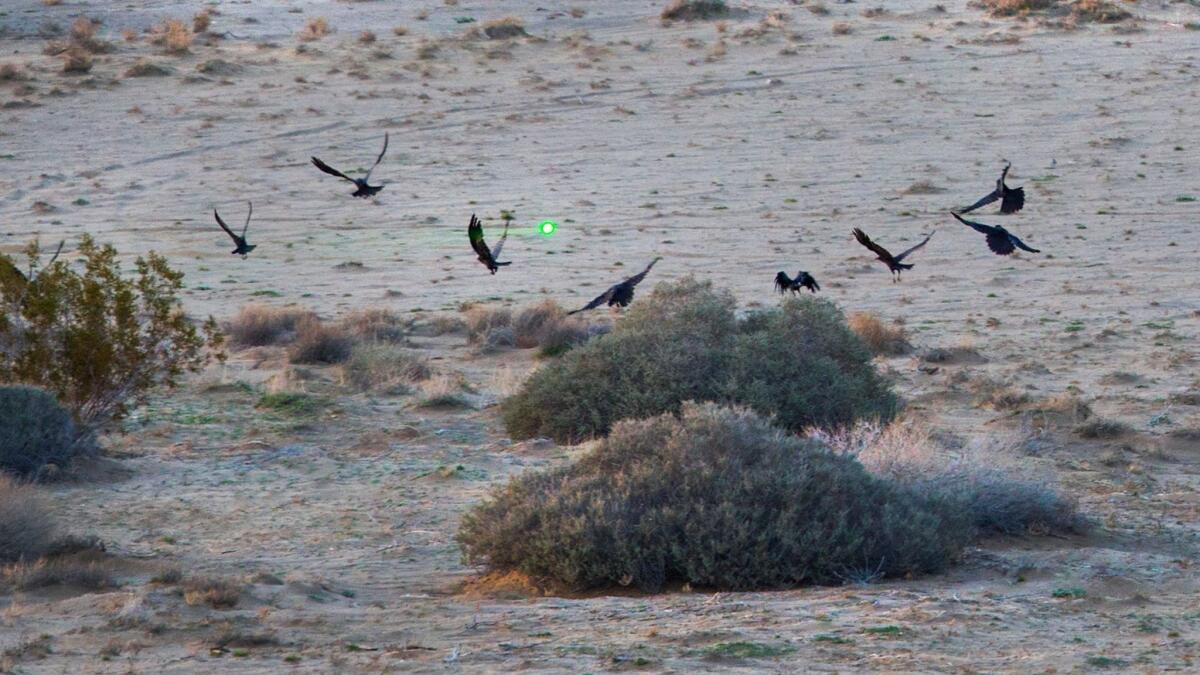To save California desert tortoises from ravens, officials turn to laser guns — and maybe chemical weapons

- Share via
Reporting from Twentynine Palms, Calif. — The U.S. Marines will soon blast the western Mojave Desert with green lasers and may someday deploy chemical weapons in an effort to beat back marauding ravens’ aerial assault on baby tortoises.
The “raven no-fly zones” will be part of the largest effort ever to relocate tortoises — an initiative the Marine Corps is attempting in exchange for congressional approval to expand the Air Ground Combat Center at Twentynine Palms by about 165 square miles in prime tortoise habitat.
The nonlethal experimental system aims to defend baby tortoises hatched from the eggs of relocated breeding adults.
Baby tortoises are voracious, grow fast and start digging burrows almost immediately. Even such impressive survival skills, however, are no match for highly social and intelligent ravens, whose populations have exploded because of the proliferation of landfills, dumpsters and sources of water including sewage ponds and golf courses.
Although adult tortoises are armored like Abrams battle tanks, with skin as rough as rhino hide, and weigh up to 15 pounds, hatchlings are a few inches long with soft, fingernail-thin shells.
This makes them “walking tortellini for ravens,” said Brian Henen, a biologist and head of the Marine Corps’ $53-million relocation effort.
“But ravens really hate laser light,” Henen said. “So, we’re going to give that technology a try on an experimental basis, along with other predator deterrents. Our main purpose is to get the tortoises out of harm’s way in areas to be used for battlefield training — and give their descendants a fighting chance.”
Baby tortoises are ‘walking tortellini for ravens.’
— Brian Henen, biologist

The anti-raven arsenal also includes “techno-tortoises”: highly realistic replicas of baby tortoises that, when pecked or bitten, emit irritants derived from grape juice concentrate, a chemical compound already used to keep birds from congregating on agricultural fields and commercial centers.
Critics point out that tortoise translocations have a poor track record.
The stress of being handled and having to adapt to unfamiliar terrain, biologists say, renders adult tortoises vulnerable to predation not only by ravens but also by dogs and coyotes. It also disrupts complex social networks linked by trails, arroyos and hibernation burrows already under siege by urban encroachment, solar and wind-energy facilities and utility corridors.
The U.S. Army’s effort to move 670 tortoises from its National Training Center near Barstow in March 2008 to new areas in the western Mojave was suspended less than a year later after 90 translocated and resident tortoises in those areas died, many of them eaten by coyotes.
The problem was linked to drought-stricken foraging grounds, where withered plants triggered a crash in rodent populations. As a result, coyotes turned to tortoises for sustenance.
This year, a series of winter storms has meant plenty of grass, vegetation and flowers for relocated tortoises to feast on.
But critics worry the effort will only hasten the local disappearance of tortoises in a region where the number of adults has fallen by about 50% over the last decade, according to surveys by federal biologists.
The California desert tortoise, whose population has dropped to an estimated 45,000 on public lands in the western Mojave, is protected under state and federal endangered species acts.
Under the relocation plan, about 100 contract biologists will help capture the adult tortoises, many of them outfitted with radio transmitters. The animals will be airlifted by helicopter to five sites on military property and nearby public lands, often in groups to help preserve their social networks, officials said.
Tortoises that test positive for respiratory diseases will not be relocated. About 60 miles of fencing is being installed to reduce the risk of tortoises being run over by off-road vehicles. Coyotes are being removed by state wildlife authorities.
The anti-raven arsenal includes ‘techno-tortoises,’ highly realistic replicas of baby tortoises that, when pecked or bitten, emit irritants.


The 2,100 baby tortoises expected to be roaming the relocation sites by September will be within striking distance of thousands of ravens, which are protected under the Migratory Bird Treaty Act, officials said.
“The Marine Corps is doing everything possible to make this relocation effort safe for tortoises,” said Larry LaPre, a biological consultant hired by the military a year ago to conduct a survey of active raven nests in trees, transmission towers and highway overpasses in the vicinity of the base.
“During the survey, I found dead baby tortoises under a few raven nests,” LaPre said. “I reported the carcasses to wildlife authorities, who had those particular ravens killed.”
“It hurt to see that happen,” he added. “Ravens are a native species — they belong here. But their population explosion is causing ecological harm.”
LaPre now leads a campaign reminding city officials and business owners in the high desert region of steps they can take to help reduce the raven invasion such as making sure that dumpsters are closed.
To boost the hatchlings’ odds of survival, the Marine Corps is studying the effectiveness of an assortment of nonlethal weapons developed by tortoise biologists Tim Shields and William Boarman.
Of particular interest to the Marines is their “raven repulsion green laser,” a high-powered, hand-held laser rifle with a scope mounted on it that Shields likes to call “a magic wand effective at more than half a mile.”
On a recent weekday, Shields led visitors to a hillside overlooking a sandy plain, where a few dozen ravens were lounging at sundown.
Ravens really hate laser light.
— Brian Henen, biologist
“Keep an eye on those ravens,” he said, putting on a pair of laser safety glasses.
Then he took aim and pulled the trigger. An intense beam of green laser light swept the desert floor below, causing the ravens to take to the air in a chaotic chorus.
Shields gave an approving nod. “It’s like scaring pirates off a ship at sea,” he said. “Which is what this laser gun was originally designed to do.”
John Marzluff, a wildlife biologist at the University of Washington and expert on raven behavior, expressed mixed feelings about the long-term effectiveness of such high-tech raven deterrents.
“My concerns are that we don’t really know how long these forms of aversion therapy will last among raven populations, which are very clever at responding to challenges,” he said. “Historically, ravens were scavengers that followed big predators like tigers and wolves across the northern hemisphere.”
Marzluff was only half-joking when he added, “Perhaps they should parachute techno-tortoises into Mojave relocation zones under cover of darkness.”
Twitter: @LouisSahagun
ALSO
Every day is bring your dog to work day at more and more L.A. offices
The troubled, covert agency responsible for moving the nation’s most lethal cargo
More to Read
Sign up for Essential California
The most important California stories and recommendations in your inbox every morning.
You may occasionally receive promotional content from the Los Angeles Times.











